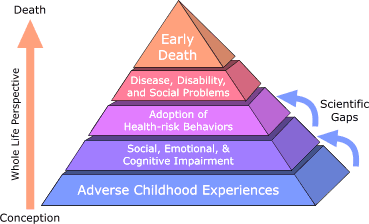 |
|
 |
 |
 |
Pyramid

The ACE Pyramid represents the conceptual framework for the Study. During
the time period of the 1980s and early 1990s information about risk
factors for disease had been widely researched and merged into public
education and prevention programs. However, it was also clear that risk
factors, such as smoking, alcohol abuse, and sexual behaviors for many
common diseases were not randomly distributed in the population. In fact, it
was known that risk factors for many chronic diseases tended to cluster,
that is, persons who had one risk factor tended to have one or more others.
Because of this knowledge, the ACE Study was designed to assess what we
considered to be “scientific gaps” about the origins of risk factors. These
gaps are depicted as the two arrows linking Adverse Childhood Experiences to
risk factors that lead to the health and social consequences higher up the
pyramid. Specifically, the study was designed to provide data that would
help answer the question: “If risk factors for disease, disability, and
early mortality are not randomly distributed, what influences precede the
adoption or development of them?” By providing information to answer this
question, we hoped to provide scientific information that would be useful
for the development of new and more effective prevention programs.
The ACE Study takes a whole life perspective, as indicated on the orange
arrow leading from conception to death. By working within this framework,
the ACE Study began to progressively uncover how childhood stressors (ACE)
are strongly related to development and prevalence of risk factors for
disease and health and social well-being throughout the lifespan.
back to top
Page last reviewed: January 10, 2008
Page last modified: December 12, 2005
Content source: Division of Adult
and Community Health, National
Center for Chronic Disease Prevention and Health Promotion |
 |

|